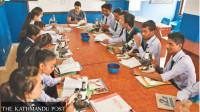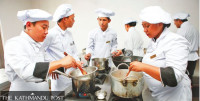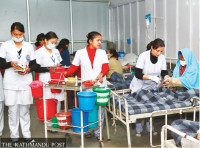Miscellaneous
A bad year for schools
The current academic session is turning out to be the worst in recent memory
Binod Ghimire
On May 25, 2011, two dozen national and regional political parties made a historic commitment to recognise ‘Schools as Zones of Peace’(SZOP), agreeing in writing to not hamper
the education sector under any pretext. The academic sector, which became the first target in every political event in the 10 years of the Maoist insurgency, sighed in relief at the announcement. It raised optimism among educational stakeholders, prompting the Ministry of Education to prepare a directive for an effective implementation of SZOP, ensuring that schools remain a safe place for children—free of any violence or political interference so that teaching and
learning could continue unhindered.
However, despite the commitment, the interference in the academic sector continued after 2011, as political parties and their sister organisations continued to target schools as a means to fulfil their interests. Such activities, granted, were limited to certain districts or private academic institutions. This year, however, operations of almost all academic institutions have been severely hit after a series of avoidable and unavoidable circumstances.
School and college operators claim that the country’s academic sector had never suffered to this extent, not even during the Maoist insurgency. The academic calendar that was already crippled by the devastating earthquake of April 25, and the subsequent aftershocks, has now been severely affected by the Tarai protests and the acute fuel shortage caused by the unofficial blockade.

“This is turning to be the worst academic year in the history of Nepal,” says Karna Bahadur Shahi, Chairperson of the Steering Committee of Association of Private Educational Institutions of Nepal (APEIN), an umbrella body of private academic institution in the country. “Academic institutions that were trying to recover from the devastation of the earthquakes have again been pushed to the brink by protests and the fuel shortage.”
The academic sector, both private and public, suffered huge physical damages after the quakes, and schools and colleges were forced to remain closed for almost a month. The Government’s Post-Disaster Needs Assessment shows 16,475 classrooms in 6,902 public schools were destroyed by the April 25 earthquake and its aftershocks. 7,266 classrooms suffered major cracks, with another 12,613 suffering minor damages. Over 1,000 schools and an equal number of colleges suffered damages in the disaster. Twenty six days of the academic calendar were forfeited due to the earthquakes alone.

The government and private educators had agreed to adjust the calendar by reducing the festive holidays and other vacations. But before the plan could materialise the various regional parties resorted to bandhas around the country affecting both schools and colleges. Academic institutions from 51 districts were affected due to the protest ignited after the promulgation of the new constitution. Though the protest is now limited to 20 Tarai districts, its consequences have affected all academic institutions in the country. “The future of millions of children is at stake due to the protest,” says Education Minister Giriraj Mani Pokhrel. “Everyone, mainly protesting parties, should think responsibly in this regard”.
The border-centric protest in the Tarai districts has forced thousands of academic institutions in the region to remain closed for the past 105 days. Due to the increasing pressure from different quarters, the agitating parties agreed to allow schools and colleges to operate in the morning. This, however, is not practical in the winter, when the temperature dips sharply in the morning hours. With less than 10 percent attendance recorded across the affected districts, the numbers are slated to shrink further as winter deepens. Similarly, the teachers from the region too are not ready to take classes in the present situation. The Chairman of the Federation of Nepali Teachers, Keshav Niraula, observes that the decision of Madhesi parties was not spontaneous, but rather an outcome of immense pressure. They, therefore, are only reluctantly agreeing to resuming schools. He says that if the protesting parties are sincere, they have to revise their border-centric protest which has been hampering lives across the nation.
-1000x0-600x0.jpg)
In the eight months since the academic session commenced in mid-April, academic institutions have hardly been open for two months and have already missed over 80 of the 220 school days. The White Paper issued by the government on Monday shows 3.47 million students in the Tarai have been directly affected due to the protest while 8.1 million students elsewhere have suffered indirectly due to fuel shortage caused by the Madhes protest. The APEIN has been warning that the entire academic session will have to be revised if there is no immediate progress in the present situation. Private educators have been claiming that the School Leaving Certificate examination will have to be postponed if the disruption continues. With just four months to go until the exams, a majority of the schools have not even completed half of their courses yet.
“This is a very serious issue,” says Vishnu Karki, an education expert. He advises the government to run extensive informal classes as the calendar has been affected severely. He sees a lack of responsibility on both agitators and government and claims that no party has taken the issue seriously. He argues that there is still room to complete the courses if both government and agitating parties are ready. According to him, the class hours can be increased, additional classes can be arranged, and the use of IT technologies can be initiated, where students can study while at home. “It is not education that is worrying me. I am worried about the culture we are passing on to our new generation,” he says. “Its effect will be deep and will be reflected for years to come”.




 16.12°C Kathmandu
16.12°C Kathmandu










